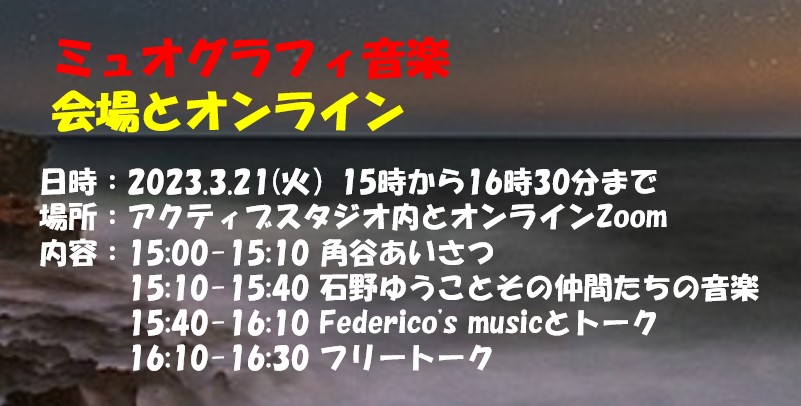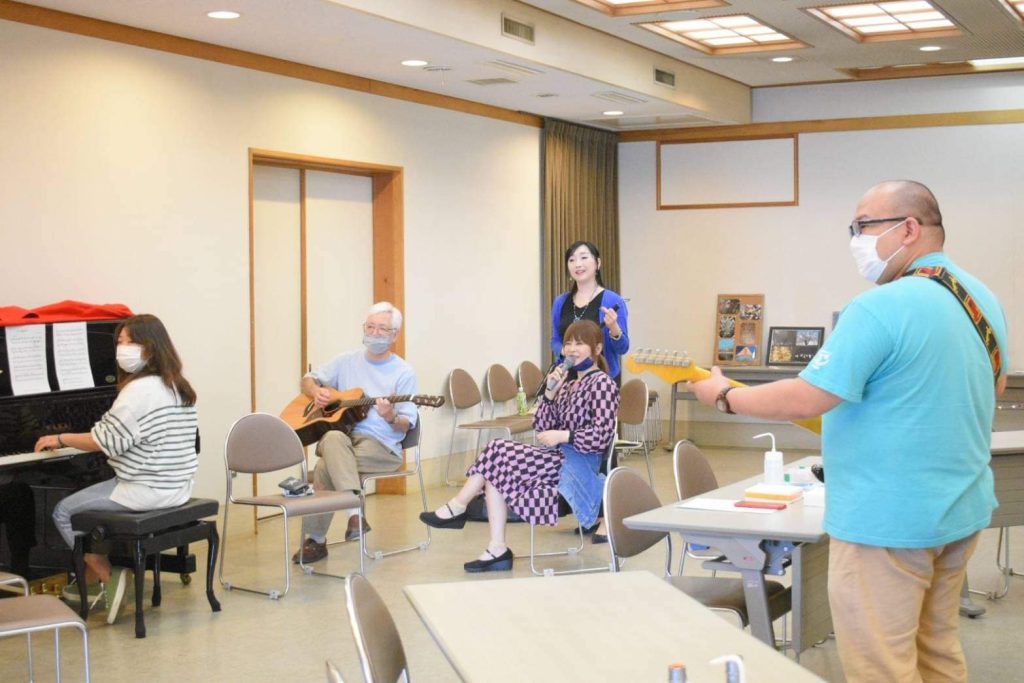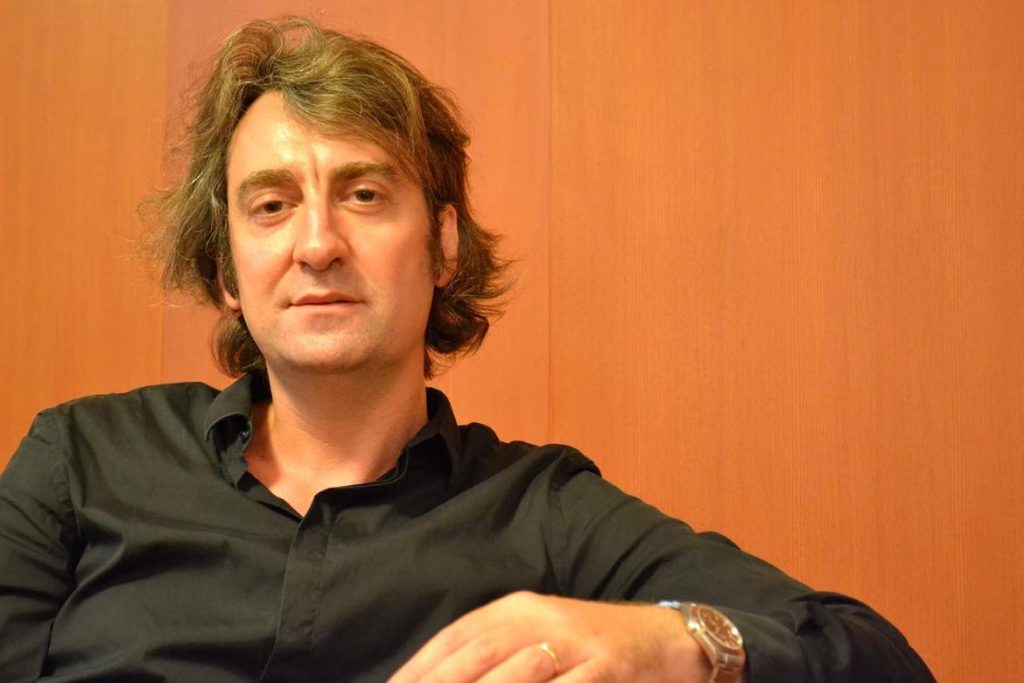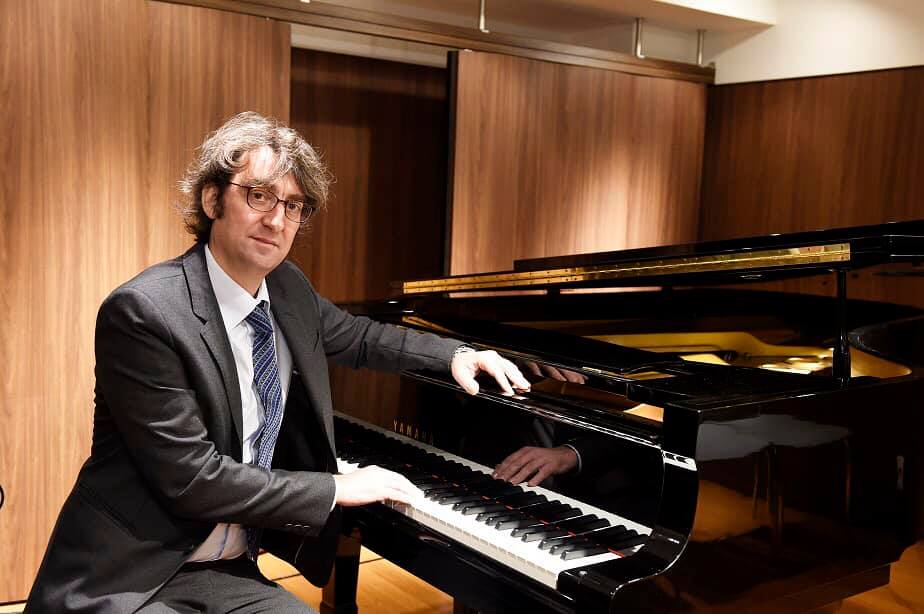
1.ミュオグラフィアート埼玉拠点,石野ゆうことその仲間たち
宮澤新樹 角井弘明 酒巻昌代 岩見扶美 Ohtsuka Miki Okome 紀子 石野ゆうこ 他
「しるべ」
~いにしへからのハーモニー~
ミュオン、ミュオグラフィに思いを馳せながら、それぞれの音や詞のハーモニーを即興演奏でセッションし表現します。
「ミュオンのうた」
詞 宮澤新樹
さらーるるる さら一
はらーるるる はら一
はてのない宇宙の妖精から
こぼれ落ちる
ミュオンの宝石のかけら
音もなく影もなく
蒼い地球にふりそそぐ
さらーるるる さら一
はらーるるる はら一
しずかに とけてゆく
天の恵みの宝石のかけら
火山 古墳 海底
地球のいのちを 輝かせる

2.Federico’s musicとトーク
MUOGRAPHY SYMPHONY

Pianist, composer and choir Conductor

Pianist, composer and choir Conductor
The Muography Symphony is a composition for large orchestra by the composer Federico Iacobucci, inspired by Muography and born from an idea of Professor Hiroyuki Tanaka. It’s the representation of the life of the particle called Muon in its journey through different situations, but it’s also a transposition in music of the main aspects related to its scientific peculiarity and interactions with our world. Muons are high-energy particles that have a very short life, compared to our normal conception of lifetime. If we try to represent them with music and then “translate” them directly into sounds we should use range, intensity and durations that are completely out of the audible spectrum of waves. Also, doing this with a symphonic orchestra forces us to compose for a limited range of pitches.
The idea was to create a frame where muons are in the highest range of the orchestra while the matter is represented by other instruments in a different region of the score. I dilated considerably the time to produce a kind of effect that is assimilable to a picture that captures an instant. The result is a musical landscape where muons move inside of it within magma and other particles.
Time is the fundamental dimension in music, without it sounds could not propagate. A constant beat is used in all the three movements. It’s a sort of measurement line. Speed changes, accelerando and rallentando, are obtained through music notation. Every one of us has a subjective perception of the passage of time. The most peculiar property of music is that you can show the whole picture in the same time that you are painting it. It’s like observing a large artwork in multiple sections, but the composer chooses the point of view from time to time. This form of art is very much appropriate to represent this scientific argument. The muon is the hero of this symphony and the solo clarinet supported by other high-pitched instruments represents it. Using a soloist gives more personality and distinction to our hero. He appears the first time in the first movement and he passes through different sets. The music tries to describe with sounds the interaction of the muons with the matter. In the first movement we can hear him interacting with a volcano; in the second he’s playing through a pyramid; in the third movement he is transported by the cosmic rays in a travel across the space-time and then released by the impact with the atmosphere and finally detected by the muon detector. When the muon‘s sound is played it generates a sort of magnetic interaction with the matter’s sound, also using an instrumental reproduction of the Doppler effect. The Doppler effect is something that we experience every day and it’s not so difficult to reproduce with sounds. The challenge is to combine an expression of the Doppler effect with an expression of the relativity of time. For example, in the second movement as the speed of the notes increases concurrently the pitch and intensity of the muon sound decreases.
In the score there are setted three lines of tempo to reflect that time differs depending on the speed an object is traveling at: one is the constant time, the observer time line; another is the muon’s speed related to its personal time; the third is the environment time, related to the matter and the audience. When the muon sound is at its top level of energy and speed, the muon time is frozen and the “human” time runs very fast. Then, while the muon tempo (tempo=speed) exponentially decreases the “human” tempo increases and finally they meet again on the constant time. The part of the symphony that introduces this element is related to the pyramid, because it’s a structure manufactured by human beings. In fact the movement is structured like a Scherzo (an humorous composition that is traditionally one of the movement of a symphony) in which the subjective feelings and perception of the human audience are positioned in the foreground.
Since Muography was born in the first half of the last century, under the suggestion of Prof. Tanaka, the ensemble uses a set of traditional instruments. To represent the high power energy of muons the solo clarinet plays mostly in its highest region, besides high-pitched instruments like crotales (upper octave) and glockenspiel. Crotales in particular have a very penetrating sound with a considerable long decay. To improve the high-energy effect of the muon these instruments are mixed with harmonics of the strings and the highest notes of harp, piano and glockenspiel. Also a bass drum, which can produce a very huge sound with a long decay, is used to represent the volcano eruption while temple blocks make a kind of metronome effect in some sections.
The premiere of Muography Symphony was performed in 2018 at the Agnelli Hall of the Italian Institute of Culture in Tokyo and in 2019 (excerpts) at The Symphony Hall in Osaka.
【Google翻訳+修正】
ミュオグラフィ交響曲は、作曲家フェデリーコ・イアコブッチによる大管弦楽のための作品で、ミュオグラフィに触発され、田中宏幸教授の着想から生まれました。 それは、さまざまな状況で旅するミュオンと呼ばれる粒子の生命を表現したものですが、その科学的特性と私たちの世界との相互作用に関連する主要な側面を音楽に置き換えたものでもあります。 ミュー粒子は、私たちの通常の寿命の概念と比較して、寿命が非常に短い高エネルギー粒子です。 それらを音楽で表現し、それを直接音に「変換」しようとする場合、波の音声スペクトルから完全に外れている範囲、強度、持続時間を使用する必要があります。 また、交響楽団でこれを行うと、限られた範囲のピッチで作曲する必要があります。
アイデアは、ミュオンがオーケストラの最高範囲にあり、物質がスコアの別の領域にある他の楽器によって表されるフレームを作成することでした。 一瞬を捉えた写真に同化できるような効果を出すために、かなり時間を延ばしました。 その結果、ミュー粒子がマグマやその他の粒子の中で移動する音楽的な風景が生まれます。
時間は音楽の基本的な次元であり、それがなければ音は伝わりません。 3つの動きすべてで一定のビートが使用されます。 一種の測定線です。 速さの変化であるアッチェレランドとラレンタンドは、楽譜から得られます。 私たちは皆、時間の経過を主観的に認識しています。 音楽の最も独特な特性は、絵を描いているのと同時に全体像を見せることができるということです。 大きなアートワークを複数のセクションで観察するようなものですが、作曲者はその時々で視点を選択します。 この形式の芸術は、この科学的議論を表現するのに非常に適しています。 ミュオンはこの交響曲の主人公であり、他の高音の楽器に支えられたクラリネットのソロがそれを表しています。 ソリストを使用すると、ヒーローにより多くの個性と特徴が与えられます。 彼は最初の楽章で初めて登場し、さまざまな場面を通過します。 この音楽はミュー粒子と物質との相互作用を音で表現しようとします。 最初の楽章では、ミュオンが火山と相互作用しているのが聞こえます。 2番目に、ミュオンはピラミッドを通して遊んでいます。 第 3 楽章では、宇宙線によって時空を横切って運ばれ、大気との衝突によって解放され、最終的にミューオン検出器によって検出されます。 ミュオンの音が再生されると、ドップラー効果の楽器の再生も使用して、物質の音との一種の磁気相互作用が生成されます。 ドップラー効果は私たちが日常的に経験しているものであり、音で再現することはそれほど難しくありません。 課題は、ドップラー効果の表現と時間の相対性の表現を組み合わせることです。 たとえば、第 2 楽章では、旋律の速度が速くなると同時にミュオン音のピッチと強度が低下します。
スコアには、オブジェクトが移動する速度に応じて時間が異なることを反映するために、テンポの 3 つのラインが設定されています。 もう 1 つは、個人的な時間に関連するミュオンの速度です。 3 つ目は、問題と聴衆に関連する環境時間です。 ミュオンの音がエネルギーと速度の最高レベルにあるとき、ミュオンの時間は凍結され、「人間の」時間は非常に速く進みます。 そして、ミュオンのテンポ(テンポ=速さ)が指数関数的に減少する一方で、「人間」のテンポが増加し、最終的にそれらは一定の時間で再会します。 この要素を紹介する交響曲の部分は、ピラミッドに関連しています。なぜなら、ピラミッドは人間によって製造された構造だからです。 実際、楽章はスケルツォ(伝統的に交響曲の楽章の 1 つであるユーモラスな構成)のように構成されており、聴く人の主観的な感情と知覚が前面に配置されています。
ミュオグラフィーは、田中教授の提案の下今世紀の前半に誕生したので、アンサンブルは様々な伝統的な楽器を使用しています。 ミュオンの高出力エネルギーを表現するために、クラリネットのソロは、クロターレ (1 オクターブ上) やグロッケンシュピールなどの高音域の楽器に加えて、主にその最高域で演奏されます。 特にクロタレスは、かなり長い減衰を伴う非常に鋭い音を持っています。 ミュオンの高エネルギー効果を改善するために、これらの楽器は弦のハーモニクスとハープ、ピアノ、グロッケンシュピールの最高音と混合されます。 また、火山の噴火を表現するために、減衰の長い非常に大きな音を出すことができるバスドラムが使用され、一部のセクションではテンプルブロックが一種のメトロノーム効果を生み出します。
Muography Symphony の初演は、2018 年に東京のイタリア文化会館のアニェッリ ホールで、2019 年に大阪の The Symphony Hall で(抜粋)上演されました。